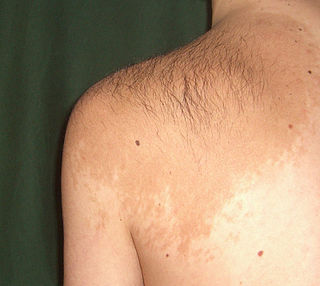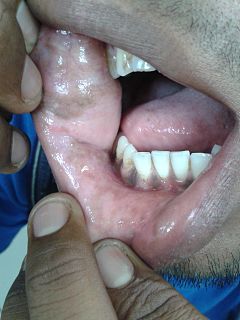Related Research Articles

Erythroderma is an inflammatory skin disease with redness and scaling that affects nearly the entire cutaneous surface. This term applies when 90% or more of the skin is affected.
Melanosis is a form of hyperpigmentation associated with increased melanin.
Perioral dermatitis is a type of skin rash. Symptoms include multiple small (1–2 mm) bumps and blisters sometimes with background redness and scale, localized to the skin around the mouth and nostrils. Less commonly the eyes and genitalia may be involved. It can be persistent or recurring and resembles particularly rosacea and to some extent acne and allergic dermatitis. The term "dermatitis" is a misnomer because this is not an eczematous process.

Becker's nevus is a skin disorder predominantly affecting males. The nevus can be present at birth, but more often shows up around puberty. It generally first appears as an irregular pigmentation on the torso or upper arm, and gradually enlarges irregularly, becoming thickened and often hairy (hypertrichosis). The nevus is due to an overgrowth of the epidermis, pigment cells (melanocytes), and hair follicles. This form of nevus was first documented in 1948 by American dermatologist Samuel William Becker (1894–1964).

Smoker's melanosis is seen with the naked eye as a brown to black pigmentation of the oral tissue i.e. the gums, cheeks or palate as well as in larynx. It is most often seen in the lower labial gingiva of tobacco users. Most easily it is found in Caucasians, due to their lack of a genetically caused melanin pigmentation.
Riehl may refer to:

Periorbital dermatitis is a skin condition, a variant of perioral dermatitis, occurring on the lower eyelids and skin adjacent to the upper and lower eyelids.

Auricular eczema is an eczema of the ear that may involve the helix, postauricular fold, and external auditory canal, with the most frequently affected site being the external canal, where it is often a manifestation of seborrheic dermatitis or allergic contact dermatitis. This is an neuroallergic inflammation of skin with evident itch.
Eyelid dermatitis is commonly related to atopic dermatitis or allergic contact dermatitis. Volatile substances, tosylamide, epoxy hardeners, insect sprays, and lemon peel oil may be implicated, with many cases of eyelid contact dermatitis being caused by substances transferred by the hands to the eyelids.
Id reactions are types of acute dermatitis developing after days or weeks at skin locations distant from the initial inflammatory or infectious site. They can be localised or generalised. This is also known as an 'autoeczematous response' and there must be an identifiable initial inflammatory or infectious skin problem which leads to the generalised eczema. Often intensely itchy, the red papules and pustules can also be associated with blisters and scales and are always remote from the primary lesion. It is most commonly a blistering rash with itchy vesicles on the sides of fingers and feet as a reaction to fungal infection on the feet, athlete's foot. Stasis dermatitis, allergic contact dermatitis, acute irritant contact eczema and infective dermatitis have been documented as possible triggers, but the exact cause and mechanism is not fully understood. Several other types of id reactions exist including erythema nodosum, erythema multiforme, Sweet's syndrome and urticaria.

Transient neonatal pustular melanosis is a cutaneous condition that presents at birth with 1- to 3-mm flaccid, superficial fragile pustules, some of which may have already resolved in utero, leaving pigmented macules.
Tar melanosis is an occupational dermatosis that occurs among tar handlers after several years of exposure, characterized by a severe widespread itching that is soon followed by the appearance of reticular pigmentation, telangiectases, and a shiny appearance of the skin.
Gougerot–Blum syndrome is a variant of pigmented purpuric dermatitis, a skin condition characterized by minute, rust-colored to violaceous, lichenoid papules that tend to fuse into plaques of various hues. Relative to other variants, it is characterized clinically by a male predominance, pruritus, with a predilection for the legs, and histologically, it features a densely cellular lichenoid infiltrate.
Hydroid dermatitis is a cutaneous condition that occurs after contact with the small marine hydroid Halecium.
Blister beetle dermatitis is a cutaneous condition that occurs after contact with any of several types of beetles, including those from the Meloidae and Oedemeridae families. Blister beetles secrete an irritant called cantharidin, a vesicant that can get onto humans if they touch the beetles.
Airbag dermatitis is caused skin irritation and trauma secondary to the deployment of airbags.
Phylloid hypomelanosis is a cutaneous condition, a syndrome occurring in patients with mosaic trisomy 13 or translocation trisomy 13.
Progressive macular hypomelanosis is a common skin condition, a disorder, observed more frequently in young women with darkly pigmented skin who originate from or reside in tropical climates.

Gustav Riehl was an Austrian dermatologist.
References
- 1 2 James, William; Berger, Timothy; Elston, Dirk (2005). Andrews' Diseases of the Skin: Clinical Dermatology (10th ed.). Saunders. ISBN 978-0-7216-2921-6.
- ↑ Dorland's Illustrated Medical Dictionary. Philadelphia: Elsevier Saunders. 2012. p. 1647.
- ↑ Ohshiro, T.; Calderhead, R. G. (1995). Laser Treatment for Naevi. Chichester, UK: John Wiley & Sons. p. 37.
| This cutaneous condition article is a stub. You can help Wikipedia by expanding it. |